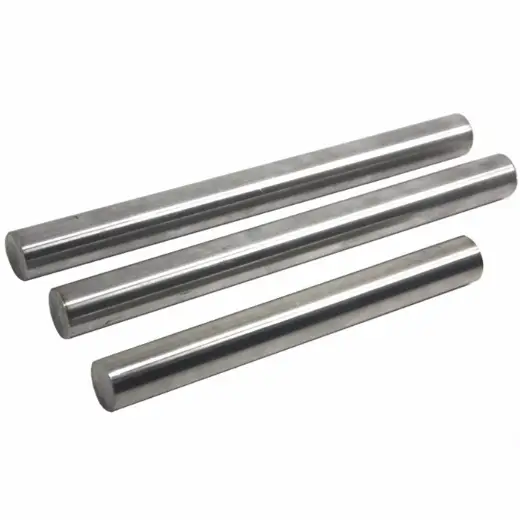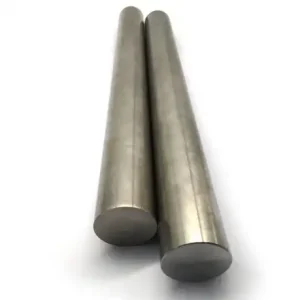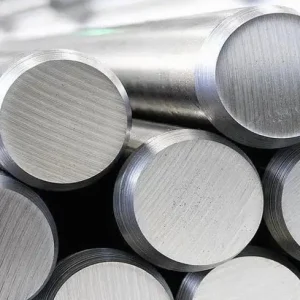17-4 H1150 bar represents one of the most versatile and widely-utilized precipitation hardening stainless steel grades in modern industrial applications. This martensitic stainless steel combines excellent corrosion resistance with exceptional mechanical properties, achieved through precise heat treatment at 1150°F (621°C). The material offers superior strength-to-weight ratios while maintaining fabrication flexibility, making it indispensable across aerospace, marine, chemical processing, and nuclear industries.
What is 17-4 H1150 Bar?
17-4 H1150 bar constitutes a precipitation hardening (PH) stainless steel that achieves its remarkable properties through controlled thermal processing. The designation "H1150" refers specifically to the aging temperature of 1150°F (621°C) applied during heat treatment, which optimizes the balance between strength and ductility.
This material belongs to the 400 series stainless steel family, characterized by its martensitic microstructure. The precipitation hardening process involves copper-rich precipitates that form during aging, significantly enhancing mechanical properties without compromising corrosion resistance. We observe that H1150 condition provides moderate strength levels while retaining excellent toughness characteristics.
The manufacturing process begins with solution annealing, followed by controlled cooling and precise aging treatment. This thermal cycle transforms the microstructure, creating fine precipitates that act as barriers to dislocation movement, thereby increasing yield and tensile strength substantially.
Chemical Composition of 17-4 H1150 Bar
The chemical composition directly influences the material's performance characteristics and heat treatment response. We present the standard composition ranges below:
| Element | Weight Percentage (%) | Function |
|---|---|---|
| Chromium (Cr) | 15.0 - 17.5 | Primary corrosion resistance |
| Nickel (Ni) | 3.0 - 5.0 | Austenite stabilizer, toughness |
| Copper (Cu) | 3.0 - 5.0 | Precipitation hardening agent |
| Manganese (Mn) | 1.0 max | Deoxidizer, sulfide formation |
| Silicon (Si) | 1.0 max | Deoxidizer, scale resistance |
| Phosphorus (P) | 0.04 max | Controlled impurity |
| Sulfur (S) | 0.03 max | Controlled impurity |
| Carbon (C) | 0.07 max | Carbide formation control |
| Niobium (Nb) | 0.15 - 0.45 | Carbide stabilizer |
| Iron (Fe) | Balance | Matrix element |
The copper content proves critical for precipitation hardening effectiveness, while chromium ensures adequate corrosion resistance. Nickel content influences the transformation behavior and final microstructural characteristics.
Mechanical Properties of 17-4 H1150 Bar
Heat treatment at H1150 condition produces specific mechanical property ranges that make this material suitable for demanding applications:
| Property | Value | Test Method |
|---|---|---|
| Tensile Strength | 145,000 - 175,000 psi | ASTM A564 |
| Yield Strength (0.2% offset) | 125,000 - 155,000 psi | ASTM A564 |
| Elongation | 10 - 16% | ASTM A564 |
| Reduction of Area | 35 - 55% | ASTM A564 |
| Hardness | 32 - 38 HRC | ASTM A564 |
| Modulus of Elasticity | 28.5 × 10⁶ psi | ASTM E111 |
| Density | 0.280 lb/in³ | Calculated |
| Impact Strength (Charpy V-notch) | 25 - 50 ft-lbs | ASTM A370 |
These properties represent optimal balance for structural applications requiring both strength and reasonable ductility. The moderate hardness level facilitates machining operations while maintaining wear resistance.
Specifications of 17-4 H1150 Bar
Manufacturing standards govern dimensional tolerances, surface finish requirements, and quality control parameters:
| Specification Category | Standard Range | Tolerance |
|---|---|---|
| Diameter Range | 0.125" - 12.000" | ±0.005" |
| Length | 12' standard, custom available | ±1/4" |
| Surface Finish | 125 μin Ra max | Per ASTM A276 |
| Straightness | 0.003"/ft max | ASTM A276 |
| Roundness/Concentricity | ±0.002" | ASTM A276 |
| Chemical Analysis | Per heat certificate | ASTM A564 |
| Mechanical Testing | Tensile, hardness required | ASTM A564 |
| Ultrasonic Testing | Class B or better | ASTM A388 |
Quality assurance protocols include comprehensive testing at various production stages to ensure consistent performance characteristics.
Standards for 17-4 H1150 Bar
Multiple international standards govern the production and application of 17-4 PH stainless steel. ASTM A564 serves as the primary specification for precipitation hardening stainless steel bars in North America. This standard defines chemical composition limits, mechanical property requirements, and testing procedures.
AMS 5604 covers aerospace applications, specifying more stringent quality requirements including enhanced cleanliness levels and additional testing protocols. The specification mandates vacuum arc remelting for improved inclusion control and fatigue performance.
European EN 10088 provides equivalent requirements, though with slight variations in composition ranges and testing methodologies. JIS G4303 governs Japanese production standards, incorporating similar technical requirements adapted for local manufacturing practices.
NACE MR0175/ISO 15156 addresses sour service applications in oil and gas environments, specifying hardness limitations and environmental testing requirements to prevent sulfide stress cracking.
Global Equivalents of 17-4 H1150 Bar
International designation systems use different nomenclature for essentially equivalent materials:
The UNS designation S17400 represents the unified numbering system identifier used throughout North America. European standards classify this material as 1.4542 under EN numbering systems, while maintaining similar chemical and mechanical requirements.
Japanese Industrial Standards designate equivalent material as SUS630, reflecting local manufacturing practices and quality standards. Chinese GB standards reference 0Cr17Ni4Cu4Nb as the corresponding grade designation.
German DIN standards historically used X5CrNiCuNb16-4 before harmonization with European EN standards. Russian GOST specifications include similar materials under different numerical designations adapted for local industry requirements.
These equivalencies facilitate international procurement and ensure material interchangeability across global supply chains, though minor compositional variations may exist between different standard systems.
Comparison: 17-4 H1150 vs 17-4 H1025
The aging temperature significantly impacts final material properties, creating distinct performance characteristics between H1150 and H1025 conditions:
| Property | H1150 Condition | H1025 Condition | Difference |
|---|---|---|---|
| Aging Temperature | 1150°F (621°C) | 1025°F (552°C) | 125°F higher |
| Tensile Strength | 145-175 ksi | 170-200 ksi | 25-30 ksi lower |
| Yield Strength | 125-155 ksi | 155-185 ksi | 30 ksi lower |
| Elongation | 10-16% | 8-12% | 4-6% higher |
| Hardness | 32-38 HRC | 38-44 HRC | 6-10 points lower |
| Toughness | Higher | Moderate | Better impact resistance |
| Machinability | Better | More difficult | Easier cutting |
| Applications | General structural | High strength critical | Different use cases |
H1150 condition prioritizes toughness and machinability, while H1025 maximizes strength at the expense of ductility. Selection depends on specific application requirements and design priorities.
Applications of 17-4 H1150 Bar
Aerospace industry utilizes this material extensively for landing gear components, actuator rods, and structural fittings where high strength-to-weight ratios prove essential. The combination of corrosion resistance and mechanical properties makes it ideal for aircraft environments exposed to various atmospheric conditions.
Marine applications include propeller shafts, pump components, and offshore platform hardware. The material's resistance to chloride environments, combined with its mechanical strength, provides reliable performance in seawater exposure conditions.
Chemical processing equipment incorporates 17-4 H1150 bars for valve components, pump shafts, and reactor internals. The corrosion resistance to various chemicals, particularly organic acids and mild alkaline solutions, ensures long service life in aggressive environments.
Nuclear power generation facilities employ this grade for control rod mechanisms, reactor vessel internals, and instrumentation components. The material's radiation resistance and mechanical stability at elevated temperatures make it suitable for nuclear service applications.
Oil and gas industry applications encompass downhole tools, valve stems, and wellhead components. The combination of strength, corrosion resistance, and hydrogen sulfide resistance (when properly heat treated) supports reliable operation in sour service conditions.
Classification of 17-4 H1150 Bar
Technical classification systems organize materials based on composition, structure, and properties:
| Classification System | Category | Designation |
|---|---|---|
| Microstructural | Martensitic | Precipitation hardening |
| Corrosion Resistance | Moderate to Good | Class 2 stainless |
| Strength Level | High Strength | 145-175 ksi range |
| Heat Treatment | Age Hardenable | H1150 condition |
| Magnetic Properties | Ferromagnetic | Moderate permeability |
| Weldability | Good with precautions | PWHT required |
| Temperature Service | Moderate | -100°F to 600°F |
| Industry Classification | Aerospace grade | AMS qualified |
These classifications help engineers select appropriate materials based on specific performance requirements and environmental conditions.
Global Market Pricing for 17-4 H1150 Bar (2025)
Current market conditions reflect global supply chain dynamics and regional manufacturing capabilities:
| Region | Price Range (USD/lb) | Market Factors |
|---|---|---|
| North America | $8.50 - $12.00 | Strong aerospace demand |
| Europe | $9.00 - $13.50 | Energy transition applications |
| Asia-Pacific | $7.50 - $11.00 | Manufacturing hub advantages |
| Middle East | $9.50 - $14.00 | Oil & gas sector demand |
| Latin America | $8.00 - $11.50 | Mining industry applications |
| Global Average | $8.50 - $12.40 | Weighted by volume |
Pricing variations reflect transportation costs, regional demand patterns, raw material availability, and local manufacturing capabilities. Premium grades commanding aerospace specifications typically carry 15-25% price premiums over standard industrial grades.
Size and Weight Parameters
Standard dimensional ranges accommodate various application requirements:
| Diameter (inches) | Weight per Foot (lbs) | Standard Lengths (feet) |
|---|---|---|
| 0.125 | 0.035 | 12, 20 |
| 0.250 | 0.141 | 12, 20 |
| 0.500 | 0.563 | 12, 20 |
| 0.750 | 1.267 | 12, 20 |
| 1.000 | 2.255 | 12, 20 |
| 1.500 | 5.074 | 12, 20 |
| 2.000 | 9.020 | 12, 20 |
| 3.000 | 20.295 | 12, 20 |
| 4.000 | 36.080 | 12, 20 |
| 6.000 | 81.180 | 12, 20 |
Custom sizes and lengths are available through specialized processing, though longer lead times and minimum quantities may apply.
Advantages of 17-4 H1150 Bar
High strength-to-weight ratio provides excellent structural efficiency, particularly valuable in aerospace and automotive applications where weight reduction directly impacts performance and fuel economy. The precipitation hardening mechanism achieves strength levels comparable to tool steels while maintaining stainless steel corrosion resistance.
Excellent machinability in H1150 condition facilitates manufacturing operations, reducing production costs and improving surface finishes. The moderate hardness level permits conventional machining techniques without requiring specialized tooling or cutting parameters.
Superior corrosion resistance in atmospheric environments, mild chemicals, and marine conditions ensures reliable long-term performance. The chromium content provides passive film formation, while copper additions enhance resistance to specific corrosive media.
Good weldability with proper procedures enables fabrication of complex assemblies. Post-weld heat treatment can restore optimum properties in weld zones, maintaining structural integrity throughout welded components.
Consistent material properties through controlled heat treatment processes ensure reliable performance and predictable design parameters. Quality control systems maintain tight tolerances on mechanical properties and dimensional characteristics.
Manufacturing Process
Raw material selection begins with high-quality stainless steel melted in electric arc or induction furnaces. Vacuum arc remelting or electroslag remelting may be employed for premium grades requiring enhanced cleanliness and inclusion control.
Initial forging operations reduce cast ingots to intermediate sizes while breaking up the cast structure and improving material homogeneity. Hot working temperatures typically range from 1900-2100°F to maintain proper flow characteristics and avoid cracking.
Solution annealing at 1900-1950°F dissolves precipitates and homogenizes the microstructure, followed by rapid cooling to retain elements in solid solution. This treatment establishes the foundation for subsequent precipitation hardening.
Rough machining to near-final dimensions occurs in the solution annealed condition when the material exhibits maximum machinability. Precision grinding or finish machining may be deferred until after aging treatment.
Precipitation hardening at 1150°F for 4 hours develops the final strength properties through controlled precipitation of copper-rich phases. Cooling rate from the aging temperature influences final hardness and toughness balance.
Final inspection includes dimensional verification, mechanical testing, and non-destructive examination to ensure compliance with applicable specifications and customer requirements.
Brazilian Procurement Case Study
Petrobras, Brazil's national oil company, required high-performance materials for offshore platform applications in the Santos Basin pre-salt fields. The challenging environment demanded materials capable of withstanding chloride exposure, moderate hydrogen sulfide levels, and dynamic loading conditions.
Technical requirements specified 17-4 H1150 bars with enhanced cleanliness levels and documented Charpy impact properties at service temperatures. Additionally, all materials required NACE MR0175 compliance for sour service applications, limiting maximum hardness to 33 HRC.
Procurement challenges included local content requirements mandating Brazilian processing of imported raw materials. This necessitated establishing heat treatment partnerships with certified local facilities capable of achieving H1150 condition while maintaining NACE compliance.
Quality assurance protocols included third-party inspection, comprehensive mechanical testing, and corrosion testing in simulated service environments. Each heat required individual certification with full traceability documentation.
The successful procurement involved 2,500 tons of various bar sizes delivered over 18 months. Material performance exceeded expectations, with no failures reported after three years of service in one of the world's most challenging offshore environments.
This case demonstrates the importance of proper material specification, quality control, and local partnership development in international procurement of critical materials.
Frequently Asked Questions
What heat treatment is required after machining 17-4 H1150 bar?
Machining operations typically do not require subsequent heat treatment unless significant material removal or surface work hardening occurs. However, if mechanical properties need restoration due to excessive machining temperatures or deformation, a stress relief treatment at 1150°F for 1-2 hours may be beneficial. Full re-aging is rarely necessary unless the material was severely overheated during machining operations.
Can 17-4 H1150 bar be welded without losing its properties?
Yes, but proper procedures are essential. Pre-heating to 400-500°F, low heat input welding techniques, and immediate post-weld heat treatment at 1150°F for 4 hours will restore optimum properties in the heat-affected zone. Matching filler metals should be used, and interpass temperatures should be controlled to prevent overheating. Without proper post-weld heat treatment, weld zones will exhibit reduced strength and ductility.
How does 17-4 H1150 bar perform in cryogenic applications?
The material maintains good toughness down to -100°F, making it suitable for moderately low temperature applications. However, for liquid nitrogen or liquid helium temperatures, impact testing should be performed to verify adequate toughness levels. The martensitic structure can become brittle at extremely low temperatures, so careful evaluation is required for cryogenic service below -150°F.
What surface treatments are compatible with 17-4 H1150 bar?
Most surface treatments are compatible, including passivation, electroplating (nickel, chrome), anodizing (with proper pre-treatment), and various coating systems. Passivation with nitric or citric acid solutions enhances corrosion resistance. Shot peening can improve fatigue performance. However, treatments involving high temperatures may affect the precipitation hardened condition and should be carefully evaluated.
What are the maximum operating temperatures for 17-4 H1150 bar?
Continuous service temperatures should not exceed 600°F to maintain full strength properties. Extended exposure to temperatures above 700°F will cause over-aging and strength reduction. For high-temperature applications, consider H900 or H1000 conditions which provide better elevated temperature stability, or alternative materials like A286 or Inconel alloys for temperatures exceeding 800°F.
References
- ASTM A564/A564M-19: Standard Specification for Hot-Rolled and Cold-Finished Age-Hardening Stainless Steel Bars and Shapes
- AMS 5604: Steel, Corrosion-Resistant, Bars, Wire, Forgings, Rings, and Extrusions 15.5Cr - 4.5Ni - 4.0Cu - 0.30Nb (0.06 - 0.10C)
- ISO 15156-3: Petroleum and natural gas industries - Materials for use in H2S-containing environments in oil and gas production
- Wikipedia: Precipitation Hardening - Metallurgical Process Overview
- NIST Materials Measurement Science Division - Stainless Steel Database and Standards





